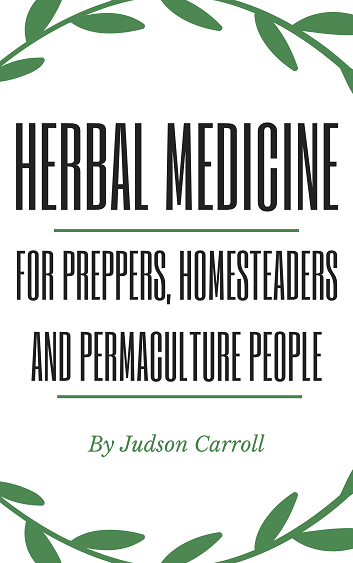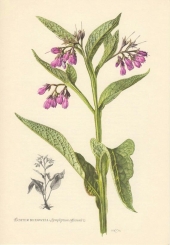https://southernappalachianherbs.blogspot.com/2021/10/herbs-for-disinfecting-wounds.html
Herbs for Disinfecting Wounds

From Herbal Medicine for Preppers, Homesteaders and Permaculture People:
The next priority after controlling bleeding is to prevent infection. This means disinfecting the wound. The nice thing about being an herbalist is that we usually have alcohol based tinctures on hand. A tincture of any herb that can be used internally and is not a vasodilator would be useful as a simple disinfectant based on the alcohol alone. However, there are many herbs that have antiseptic and even antibiotic properties that can be used both as a tea/soak or as a tincture.
As I mentioned before, Pine is antiseptic. A simple tea of the needles or pitch can be quick and easy to obtain first aid to disinfect wounds.
Other trees that can be used are: Balsam Fir (abies), Catalpa bark, Dogwood (cornus) bark, Beech (fagus) tar, Walnut (juglans) inner bark and leaves, Chinese Privett (ligustrum) fruit, Sweetgum (liquidambar) resin, Chinaberry (melizia) fruit, Bayberry (myrica) bark, Poplar (populus) stem bark, Oak (quercus) bark, Sumac (rhus... NOT poison sumac!) bark, Willow (salix) bark, Elder (sambucus) blossoms, Sassafras root, Styrax stem resin, Slippery Elm (ulmus) powdered bark, Hercules Club (zanthoxylum) berries.
Keep in mind that the above list is only of the basic families of trees. In most any area, there are several varieties of oaks, pines, etc, all of which can be used interchangeably. When one considers how many people over time have died in the wilderness, perhaps due to the slip of a knife or a mistake with an axe, it brings to mind a Bible quote, "My people die for lack of knowledge." Trees are often among our most powerful and easily attainable herbs. For more information on the medicinal use of trees, please see my book, "Look Up! The Medicinal Trees of the American South, Mid-Atlantic Region. More than 400 species of native and introduced trees grow in my region, so it is useful to most anyone, anywhere, and is the only comprehensive work on using trees as herbal medicine.
Another common plant family has saved countless lives over the centuries - the alliums. This family includes Garlic, Onions, Shallots and Leeks. The entire family is strongly antiseptic and antibiotic. Throughout history, people have used garlic and onions to treat wounds and infections. Most often, onions have been sliced and used as a poultice, however the juice pressed from onions and garlic is far more effective for deeper wounds. Onion or garlic juice is also an excellent cure for earaches and infections, simply dripped in the ear. In the Appalachian Mountains, the most valued herb in this family is the wild Ramp. Ramps are either wild Leeks or Wild Garlic, depending on who you ask. The same plant is called Ramson in Europe. Ramps are among the first wild foods we can forage, popping up in the woods, usually in cool, shady areas near creeks, and lasting for only a few weeks. Ramps have a strong, sweet Garlic and Leek flavor, with very little heat. Eating them raw, until one's body begins to smell of Ramps, is considered a "spring tonic", blood cleanser and preventative for colds and flus. Ramps and all Wild Onions may also be used to disinfect wounds. These plants have few look-a-likes, but the following maxim will ensure choosing the right plant, "If it looks like an onion AND smells like an onion, it is an onion. If it does not smell like an onion, it is not an onion, no matter what it looks like." The same is true of the entire family - they smell like Onions, Garlic, Shallots and Leeks. Alliums grow from bulbs. Any plant that grows from a bulb, but does not smell like an allium could be poisonous and requires further identification. In the mountains, where I live, Ramps may be confused with Lilly of The Valley, which contains digitalis-like compounds.
Fr. Künzle wrote of Ramsons:
In our god-blessed mountains, wild and in abundance grows a wonderful, blood-cleansing herb, the wild garlic, called Ramsons or as it is called in this part of the world: Rämschelen or Rimschelen. It tastes like strong chives, looks like the leaves of the dog rose, but is immediately recognized by its taste. In March it starts appearing in rich soil in shady places, under trees, under hedges and at the edges of forests, etc., from down in the valley up to the Alps. You cut the wild garlic like chives and throw a lot of it into the soup; many eat it and prepare it just like salad. It cleans the whole body, drives out sick, tangled substances, makes the blood healthy, drives away and kills toxic substances.
The herb dies in June and disappears. Children and unexperienced are never to be sent out to collect Ramsons, as they could easily bring home the poisonous and deadly meadow saffron (Colchicum). The taste of the Ramson is the safest identification for the unexperienced people, as this plant smells like garlic, which is not the case with the Meadow Saffron.
Permanently sick people, people with eczema and abscesses, pale people and rheumatics should worship wild garlic like gold, as well as chives, garlic and onions. The Jews certainly owe the tenacity and perseverance of their race partly thanks to their 4,000-year-old habit of eating garlic. The well-known and famous Alpine leek (Allium victorialis) is also a leek variety and therefore has its power.
Another common category of plants that are strongly antiseptic are those that contain berberine. Berberine is an alkaloid found in plants that have bright yellow roots. These include, Goldenseal (hydrastis), Coptis trifolia or "Gold Thread", Oregon Grape (mahonia) and Barberry (berberis). In early America, Goldenseal was considered a veritable "cure-all" and was valued almost as highly as Ginseng. As such, it was severely over-harvested. To this day, people will shoot each other over Ginseng and Goldenseal! Responsible herbalists encourage our readers not to use any Goldenseal, unless it is cultivated - farm or garden grown. Goldenseal could be very important to survival if supply chains and economies are disrupted. This plant simply needs an opportunity to recover and re-populate. Coptis is a small wildflower that can be found in the wilderness or grown in the garden - it grows faster than Goldenseal and is a reliable substitute. By far though, Oregon Grape and Barberry are the most widespread and easily attainable of these herbs - the mahonias and berberis families have nearly 100 members that grow wild and are popular landscaping plants; some are even considered invasive. These bushes or shrubs have large roots. Digging up one can provide years' worth of tincture for a family. The bark and leaves of Oregon grape contain smaller amounts of berberine and can be used if the root is unavailable. A tea or tincture of any of these berberine containing plants may be considered primary treatment for wounds and any condition requiring an antibacterial disinfectant. Soaks of a strong decoction are especially useful for deep puncture wounds.
Calendula or "Pot Marigold" (Calendula officinalis) is an herb used to treat many skin conditions. It is also an effective antiseptic. Calendula is also effective for fungal infections. It may be used as a wash or bath. It may be tinctured. However, Calendula is especially effective as an ointment. Maria Treben's formula for an ointment is:
2 heaped double handfuls of Calendula (leaves, stems and flowers) are finely chopped. 500 gm. of lard is heated and the chopped Calendula is added, stirred, the pan removed from the stove, covered and left to stand for a day. The next day it is warmed, filtered through a piece of
linen and poured into previously prepared clean jars.
Elecampane is a very important herb that was much more widely used in times past. Specifically, Elecampane is used as a lung herb, for coughs, asthma, bronchitis, pneumonia, etc. Elecampane has antiseptic and antibiotic properties. It is a very large, pretty flower - something between a yellow daisy and a sunflower in appearance. The root is edible. This one belongs in your garden or landscape.
Wintergreen or Teaberry (Gaultheria procumbens) may be used as an antiseptic wash. The essential oil of Wintergreen though, should not be used as it is absorbed through the skin and is toxic to the liver.
Horseradish (Amoracia rusticana) is the same plant made into a spicey condiment. Horseradish has many herbal uses that we will explore further. But, a tea made of the root can be used as an antiseptic wash.
Spikenard (Aralia racemosa) may be used as a poultice or wash for infected wounds.
German Chamomile (Chamomilla recutita) oil is antibacterial and antifungal.
Horsemint (Monarda punctata) like is high in thymol, an antiseptic essential oil.
Common Tansy (Tanacetum vulgare) is an antiseptic herb with many other uses, but it is not much used anymore because the oil of Tansy is very poisonous. Tansy cannot be sold in the US, so if you find it in the wild, use with care.
Spearmint (Mentha spicata) is antiseptic. As mentioned, several Mints are antimicrobial. Mint oils can be toxic in large doses
Hops (Humulus lupulus) yes the same Hops used in beer, is antimicrobial and antiseptic.
Thyme (Thymus) All the Thymes are useful medicinally. This is the same herb as the common kitchen Thyme, although wild Thyme may be a bit stronger. While particularly valued as a respiratory herb, Thyme is antiseptic and antibacterial.
The above article is an excerpt from my new book Herbal Medicine for Preppers, Homesteaders and Permaculture People

You can read about and purchase Herbal Medicine for Preppers, Homesteaders and Permaculture People here: southernappalachianherbs.blogspot.com/2021/10/herbal-medicine-for-preppers.html
Also available on Amazon: Herbal Medicine for Preppers, Homesteaders and Permaculture People: Carroll, Judson: 9798491252923: Amazon.com: Books
Disclaimer
The information on this site is not intended to diagnose or treat any disease or condition. Nothing on this site has been evaluated or approved by the FDA. I am not a doctor. The US government does not recognize the practice of herbal medicine and their is no governing body regulating herbalists. Therefore, I'm just a guy who studies herbs. I am not offering any advice. I won't even claim that anything I write is accurate or true! I can tell you what herbs have "traditionally been used for." I can tell you my own experience and if I believe an herb helped me. I cannot, nor would I tell you to do the same. If you use any herb I, or anyone else, mentions you are treating yourself. You take full responsibility for your health. Humans are individuals and no two are identical. What works for me may not work for you. You may have an allergy, sensitivity or underlying condition that no one else shares and you don't even know about. Be careful with your health. By continuing to read my blog you agree to be responsible for yourself, do your own research, make your own choices and not to blame me for anything, ever.

 6
6






 1
1











